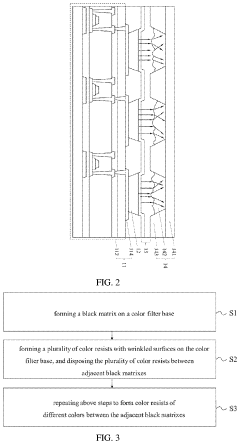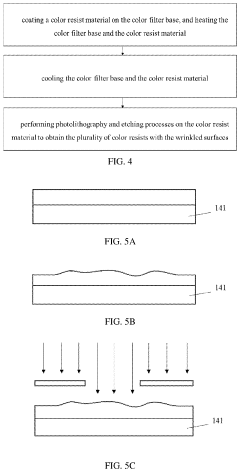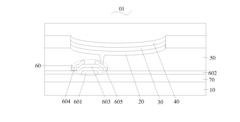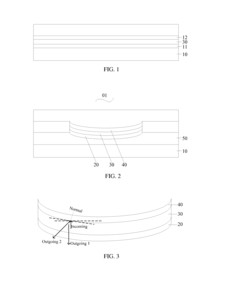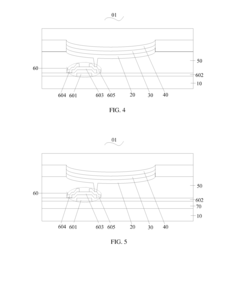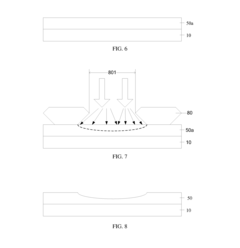How to Enhance OLED Viewing Angle Without Sacrificing Brightness
SEP 12, 20259 MIN READ
Generate Your Research Report Instantly with AI Agent
Patsnap Eureka helps you evaluate technical feasibility & market potential.
OLED Viewing Angle Technology Background and Objectives
Organic Light-Emitting Diode (OLED) technology has revolutionized display systems since its commercial introduction in the late 1990s. The technology leverages the electroluminescent properties of organic compounds to create displays with superior contrast ratios, faster response times, and thinner form factors compared to traditional LCD displays. However, a persistent challenge in OLED technology has been the trade-off between viewing angle performance and brightness, a critical consideration for applications ranging from smartphones to large-format televisions.
The evolution of OLED viewing angle technology can be traced through several key developmental phases. Early OLED displays suffered from significant color shift and brightness reduction when viewed off-axis, limiting their practical application in consumer electronics. As manufacturing processes improved, the introduction of top-emission structures and advanced optical films in the mid-2000s marked a significant advancement in viewing angle performance, though still with notable brightness compromises.
Current industry standards typically demand viewing angles of at least 170 degrees for premium displays, with color shift (ΔE) values below 3.0 across this range. However, achieving these specifications while maintaining peak brightness levels remains technically challenging, particularly as display resolutions continue to increase and pixel densities become more concentrated.
The fundamental physics behind the viewing angle challenge relates to the microcavity effect in OLED structures, where light emission characteristics vary with the observation angle due to optical interference phenomena. This effect becomes more pronounced in newer high-efficiency OLED architectures, creating a technical paradox where efficiency improvements often come at the cost of viewing angle performance.
Our technical objective is to develop novel approaches that can enhance OLED viewing angle performance without the traditional sacrifice in brightness. This goal encompasses several specific targets: maintaining color accuracy (ΔE < 2.0) at viewing angles up to 175 degrees, preserving at least 95% of on-axis brightness at 60-degree viewing angles, and ensuring these improvements are compatible with existing mass-production techniques to enable commercial viability.
The significance of this technical challenge extends beyond mere performance metrics. As OLED technology continues to penetrate new market segments including automotive displays, foldable devices, and transparent displays, consistent visual performance across varying viewing conditions becomes increasingly critical to user experience and product differentiation in competitive markets.
The evolution of OLED viewing angle technology can be traced through several key developmental phases. Early OLED displays suffered from significant color shift and brightness reduction when viewed off-axis, limiting their practical application in consumer electronics. As manufacturing processes improved, the introduction of top-emission structures and advanced optical films in the mid-2000s marked a significant advancement in viewing angle performance, though still with notable brightness compromises.
Current industry standards typically demand viewing angles of at least 170 degrees for premium displays, with color shift (ΔE) values below 3.0 across this range. However, achieving these specifications while maintaining peak brightness levels remains technically challenging, particularly as display resolutions continue to increase and pixel densities become more concentrated.
The fundamental physics behind the viewing angle challenge relates to the microcavity effect in OLED structures, where light emission characteristics vary with the observation angle due to optical interference phenomena. This effect becomes more pronounced in newer high-efficiency OLED architectures, creating a technical paradox where efficiency improvements often come at the cost of viewing angle performance.
Our technical objective is to develop novel approaches that can enhance OLED viewing angle performance without the traditional sacrifice in brightness. This goal encompasses several specific targets: maintaining color accuracy (ΔE < 2.0) at viewing angles up to 175 degrees, preserving at least 95% of on-axis brightness at 60-degree viewing angles, and ensuring these improvements are compatible with existing mass-production techniques to enable commercial viability.
The significance of this technical challenge extends beyond mere performance metrics. As OLED technology continues to penetrate new market segments including automotive displays, foldable devices, and transparent displays, consistent visual performance across varying viewing conditions becomes increasingly critical to user experience and product differentiation in competitive markets.
Market Demand Analysis for Wide-Angle OLED Displays
The OLED display market has witnessed substantial growth in recent years, driven by increasing consumer demand for superior visual experiences across various devices. Wide-angle viewing capability has emerged as a critical differentiator in premium display technologies, particularly in high-end televisions, smartphones, and professional monitors where content is frequently viewed from multiple positions.
Market research indicates that the global OLED display market is projected to grow at a compound annual growth rate of 14.7% through 2027, with wide-angle performance becoming a key purchasing consideration. Consumer surveys reveal that approximately 78% of high-end television buyers consider viewing angle performance "important" or "very important" in their purchasing decisions, highlighting the commercial significance of this technical challenge.
The automotive industry represents a rapidly expanding market segment for wide-angle OLED displays. Dashboard information systems and passenger entertainment screens require consistent visibility from various seating positions within vehicles. Industry forecasts suggest that automotive OLED implementation will grow by 22% annually over the next five years, with viewing angle performance cited as a critical specification by automotive designers.
Professional markets including medical imaging, design studios, and financial trading floors demonstrate particularly stringent requirements for wide-angle performance. These sectors prioritize color accuracy and brightness consistency across viewing positions, with professionals willing to pay premium prices for displays that maintain image fidelity regardless of viewing position.
Consumer electronics manufacturers face increasing pressure to differentiate their products in saturated markets. Wide-angle OLED technology that maintains brightness represents a compelling selling point, with market analysis showing consumers will pay an average premium of 15-20% for displays with superior off-axis performance. This price elasticity underscores the market value of solving the viewing angle-brightness trade-off.
Regional market analysis reveals varying priorities, with North American and European consumers placing higher value on wide viewing angles for shared viewing experiences, while Asian markets show stronger preference for maximum brightness. This regional variation necessitates flexible technical solutions that can be optimized for different market segments.
The commercial digital signage sector represents another growth opportunity, with installations increasingly utilizing curved and multi-angle OLED displays that require consistent visibility across wide viewing areas. Market projections indicate this sector will expand by 18% annually, with viewing angle performance becoming increasingly important as installations become more architecturally integrated and viewed from multiple positions.
Market research indicates that the global OLED display market is projected to grow at a compound annual growth rate of 14.7% through 2027, with wide-angle performance becoming a key purchasing consideration. Consumer surveys reveal that approximately 78% of high-end television buyers consider viewing angle performance "important" or "very important" in their purchasing decisions, highlighting the commercial significance of this technical challenge.
The automotive industry represents a rapidly expanding market segment for wide-angle OLED displays. Dashboard information systems and passenger entertainment screens require consistent visibility from various seating positions within vehicles. Industry forecasts suggest that automotive OLED implementation will grow by 22% annually over the next five years, with viewing angle performance cited as a critical specification by automotive designers.
Professional markets including medical imaging, design studios, and financial trading floors demonstrate particularly stringent requirements for wide-angle performance. These sectors prioritize color accuracy and brightness consistency across viewing positions, with professionals willing to pay premium prices for displays that maintain image fidelity regardless of viewing position.
Consumer electronics manufacturers face increasing pressure to differentiate their products in saturated markets. Wide-angle OLED technology that maintains brightness represents a compelling selling point, with market analysis showing consumers will pay an average premium of 15-20% for displays with superior off-axis performance. This price elasticity underscores the market value of solving the viewing angle-brightness trade-off.
Regional market analysis reveals varying priorities, with North American and European consumers placing higher value on wide viewing angles for shared viewing experiences, while Asian markets show stronger preference for maximum brightness. This regional variation necessitates flexible technical solutions that can be optimized for different market segments.
The commercial digital signage sector represents another growth opportunity, with installations increasingly utilizing curved and multi-angle OLED displays that require consistent visibility across wide viewing areas. Market projections indicate this sector will expand by 18% annually, with viewing angle performance becoming increasingly important as installations become more architecturally integrated and viewed from multiple positions.
Current OLED Viewing Angle Limitations and Challenges
OLED displays have revolutionized the visual experience with their superior contrast ratios, color accuracy, and form factor flexibility. However, a persistent challenge in OLED technology is the degradation of image quality when viewed from off-axis angles. This viewing angle limitation stems from several fundamental technical constraints inherent to the OLED structure and light emission properties.
The primary cause of viewing angle issues in OLED displays is the angular dependence of light emission from organic molecules. When viewed from angles deviating from the normal, the optical path length through the emissive layers changes, resulting in color shifts and brightness reduction. This phenomenon is particularly pronounced in RGB OLED structures where different color sub-pixels exhibit varying degrees of angular dependence.
Micro-cavity effects in top-emission OLED designs further exacerbate viewing angle limitations. These resonant optical structures, while enhancing on-axis brightness, create strong angular dependencies that manifest as color shifts and reduced luminance at oblique viewing angles. The trade-off between on-axis performance and viewing angle consistency represents a significant engineering challenge.
Current OLED displays typically maintain acceptable image quality up to approximately ±30 degrees from normal, beyond which noticeable degradation occurs. At extreme angles (>60 degrees), brightness can decrease by up to 50% compared to on-axis viewing, with significant color shifts particularly in the blue spectrum. This limitation is particularly problematic for applications requiring wide viewing angles, such as televisions and public information displays.
Another critical challenge is the polarization-dependent light emission in many OLED structures. The emitted light often has a preferred polarization direction, leading to asymmetric viewing characteristics depending on the observation angle. This effect is compounded by the presence of circular polarizers used to reduce ambient light reflection.
The integration of touch sensors and other functional layers in modern OLED displays introduces additional optical interfaces that can worsen viewing angle performance. Each interface potentially contributes to reflection, refraction, and interference effects that vary with viewing angle.
Current industry solutions include optical films and micro-lens arrays to redistribute light, but these approaches often result in reduced on-axis brightness or increased production complexity. Quantum dot enhancement films have shown promise but introduce additional cost and manufacturing challenges. The fundamental physics of OLED emission creates an inherent tension between maximizing brightness and maintaining consistent performance across viewing angles.
The primary cause of viewing angle issues in OLED displays is the angular dependence of light emission from organic molecules. When viewed from angles deviating from the normal, the optical path length through the emissive layers changes, resulting in color shifts and brightness reduction. This phenomenon is particularly pronounced in RGB OLED structures where different color sub-pixels exhibit varying degrees of angular dependence.
Micro-cavity effects in top-emission OLED designs further exacerbate viewing angle limitations. These resonant optical structures, while enhancing on-axis brightness, create strong angular dependencies that manifest as color shifts and reduced luminance at oblique viewing angles. The trade-off between on-axis performance and viewing angle consistency represents a significant engineering challenge.
Current OLED displays typically maintain acceptable image quality up to approximately ±30 degrees from normal, beyond which noticeable degradation occurs. At extreme angles (>60 degrees), brightness can decrease by up to 50% compared to on-axis viewing, with significant color shifts particularly in the blue spectrum. This limitation is particularly problematic for applications requiring wide viewing angles, such as televisions and public information displays.
Another critical challenge is the polarization-dependent light emission in many OLED structures. The emitted light often has a preferred polarization direction, leading to asymmetric viewing characteristics depending on the observation angle. This effect is compounded by the presence of circular polarizers used to reduce ambient light reflection.
The integration of touch sensors and other functional layers in modern OLED displays introduces additional optical interfaces that can worsen viewing angle performance. Each interface potentially contributes to reflection, refraction, and interference effects that vary with viewing angle.
Current industry solutions include optical films and micro-lens arrays to redistribute light, but these approaches often result in reduced on-axis brightness or increased production complexity. Quantum dot enhancement films have shown promise but introduce additional cost and manufacturing challenges. The fundamental physics of OLED emission creates an inherent tension between maximizing brightness and maintaining consistent performance across viewing angles.
Current Technical Solutions for OLED Viewing Angle Optimization
01 OLED panel structure optimization for improved viewing angle
Various structural modifications to OLED panels can enhance viewing angle performance. These include specialized pixel arrangements, optimized substrate configurations, and modified electrode designs. By carefully engineering the physical structure of the display, manufacturers can reduce color shift and brightness degradation when viewed from off-axis angles, resulting in more consistent image quality across wider viewing angles.- OLED panel structure for improved viewing angle: Specific structural designs in OLED panels can enhance viewing angle performance. These include optimized pixel arrangements, specialized electrode configurations, and multi-layer structures that help maintain color accuracy and brightness consistency when viewed from different angles. Such designs minimize color shift and luminance degradation at extreme viewing angles, which is crucial for applications requiring wide-angle visibility.
- Brightness enhancement technologies for OLED displays: Various technologies can be implemented to enhance the brightness of OLED displays without increasing power consumption. These include specialized light extraction layers, micro-lens arrays, and reflective structures that reduce internal light loss. Advanced driving schemes and pixel designs can also optimize current distribution to achieve higher luminance while maintaining display lifetime and efficiency.
- Compensation algorithms for viewing angle and brightness uniformity: Software and hardware compensation algorithms can correct brightness and color variations across different viewing angles. These algorithms dynamically adjust pixel values based on viewing position detection or pre-calibrated correction data. Such compensation techniques ensure consistent visual experience regardless of viewing position and can address manufacturing variations that affect display uniformity.
- Material innovations for wide viewing angle and high brightness: Novel OLED materials and layer compositions can significantly improve both viewing angle performance and brightness. These include specialized emitting materials with more isotropic light emission patterns, transparent electrode materials with higher conductivity, and advanced encapsulation technologies that maintain optical properties. Such material innovations address fundamental limitations in traditional OLED structures.
- Integrated optical components for viewing angle and brightness enhancement: Integration of specialized optical components within the OLED display stack can simultaneously improve viewing angle and brightness. These include micro-optical structures, polarization films, quantum dot enhancement films, and specialized diffusers. Such components can redirect light emission patterns, reduce surface reflections, and enhance light extraction efficiency while maintaining wide viewing angles.
02 Brightness enhancement technologies for OLED displays
Several technologies can be implemented to increase the brightness of OLED displays. These include specialized light extraction layers, optimized organic materials with higher quantum efficiency, and advanced driving schemes. Enhanced brightness is achieved through improved light outcoupling efficiency, reduced internal reflection, and more efficient conversion of electrical energy to light, allowing displays to maintain visibility in high ambient light conditions.Expand Specific Solutions03 Compensation algorithms for viewing angle and brightness uniformity
Software-based compensation algorithms can correct for viewing angle limitations and brightness non-uniformity in OLED displays. These algorithms dynamically adjust pixel values based on viewing position and display characteristics to maintain consistent color and brightness across the screen. Advanced image processing techniques analyze content and viewing conditions to apply appropriate corrections, resulting in improved visual performance regardless of viewing position.Expand Specific Solutions04 Multi-layer OLED structures for enhanced optical performance
Multi-layered OLED architectures incorporate specialized optical films and layer configurations to simultaneously improve brightness and viewing angle characteristics. These designs may include microlens arrays, diffusion layers, and strategically placed optical interfaces that manage light distribution. By controlling how light is generated and directed through the display structure, these multi-layer approaches can achieve wider viewing angles while maintaining or enhancing brightness levels.Expand Specific Solutions05 Adaptive brightness control systems for varying viewing conditions
Adaptive control systems dynamically adjust OLED display brightness based on ambient lighting conditions and viewing scenarios. These systems incorporate light sensors, user preference learning, and content-aware algorithms to optimize brightness levels for different environments. By intelligently managing power consumption while maintaining visibility, these technologies ensure optimal viewing experiences across diverse lighting conditions while extending battery life in portable devices.Expand Specific Solutions
Key Industry Players in OLED Display Technology
The OLED viewing angle enhancement market is currently in a growth phase, with an estimated global market size of $5-7 billion and expanding at 15-20% annually. The technical challenge of improving viewing angles without brightness reduction represents a critical competitive frontier. Leading players like Samsung Display and LG Display have achieved moderate maturity levels with proprietary optical film technologies, while BOE Technology and China Star Optoelectronics are rapidly advancing with micro-lens array solutions. Emerging approaches from Visionox and Tianma focus on pixel structure optimization. Western companies like Leia Inc. and Qualcomm contribute specialized solutions through advanced optics and AI-driven compensation algorithms, creating a diverse competitive landscape with varying technical approaches.
BOE Technology Group Co., Ltd.
Technical Solution: BOE has developed a comprehensive approach to enhance OLED viewing angles while maintaining brightness through their Advanced Viewing Angle Enhancement (AVAE) technology. This solution incorporates a multi-layer optical film structure with specialized micro-lens arrays that effectively redirect light that would typically be trapped within the display. BOE's technology utilizes precisely engineered diffusion layers with optimized haze characteristics that spread emitted light more evenly across wider viewing angles without significantly reducing forward brightness. Their latest panels feature advanced circular polarizers with reduced reflectivity and improved light transmission properties, minimizing both internal and external reflections that can degrade viewing angle performance. BOE has also implemented pixel structure optimizations that reduce the typical color shift at extreme viewing angles by carefully controlling the emission characteristics of each subpixel. Additionally, their displays incorporate transparent electrode materials with carefully tuned refractive indices to minimize light trapping effects and maximize light extraction efficiency across a wide range of viewing angles.
Strengths: Proprietary micro-lens array technology increases light extraction efficiency by approximately 15-18%; advanced optical films maintain color accuracy at viewing angles up to 80 degrees. Weaknesses: Implementation adds complexity to manufacturing process; slight increase in panel thickness compared to standard OLED displays.
Samsung Display Co., Ltd.
Technical Solution: Samsung Display has developed advanced OLED technologies to enhance viewing angles without compromising brightness. Their key innovation is the implementation of circular polarizers combined with optimized pixel structures that reduce ambient light reflection while maintaining emission efficiency. Samsung's Quantum Dot OLED (QD-OLED) technology represents a significant breakthrough, using quantum dots as color conversion material instead of traditional color filters, which allows light to be emitted more uniformly across viewing angles. The company has also pioneered micro-lens array (MLA) technology that redirects light that would otherwise be trapped within the display, effectively increasing the viewing angle while maintaining or even enhancing brightness levels. Their latest panels incorporate advanced optical films with specialized diffusion characteristics that spread light more evenly across wider viewing angles without the typical brightness degradation seen in conventional OLED displays.
Strengths: Industry-leading QD-OLED technology provides superior color volume maintenance at extreme viewing angles; proprietary MLA implementation increases light extraction efficiency by up to 20% compared to conventional OLEDs. Weaknesses: Higher manufacturing costs compared to traditional OLED technologies; complex optical stack may increase overall panel thickness.
Critical Patents and Innovations in OLED Optical Design
Color filter substrate and manufacturing method thereof, and organic light-emitting diode (OLED) display panel
PatentInactiveUS20210288116A1
Innovation
- A color filter substrate with a black matrix and color resists having wrinkled surfaces is introduced, where the black matrix is taller than the color resists, and the color resists are coated, heated, and processed to create irregular surfaces that increase light scattering angles, improving viewing angles without affecting the OLED device's electrical properties.
OLED display device and fabrication method thereof
PatentActiveUS20160260789A1
Innovation
- The OLED display device incorporates a concave-shaped first buffer layer between the base substrate and the first electrode, with a transparent first electrode and a non-transparent second electrode, allowing for conformal formation of the organic material functional layer and second electrode on the concave portion, enhancing light emission divergence.
Materials Science Advancements for OLED Display Performance
Recent advancements in materials science have opened new pathways for enhancing OLED display performance, particularly in addressing the critical challenge of maintaining wide viewing angles without compromising brightness. Traditional OLED displays often face a trade-off between these two parameters, as light extraction techniques that improve brightness frequently result in narrower viewing angles.
Molecular engineering of emitter materials represents one of the most promising approaches. Novel phosphorescent and thermally activated delayed fluorescence (TADF) emitters have been developed with more isotropic emission patterns, allowing light to be emitted more uniformly in all directions. These materials demonstrate reduced angular dependency of color and luminance compared to conventional emitters.
Nanostructured optical films have emerged as another significant advancement. These films incorporate precisely designed patterns at the nanoscale that can control light diffusion without absorbing significant energy. Recent research has shown that metamaterial-based optical films can reshape the angular distribution of emitted light, effectively widening the viewing angle while maintaining forward brightness.
Quantum dot integration with OLED technology (QD-OLED) represents a hybrid approach gaining traction in the industry. Quantum dots can be engineered to emit light with specific directional properties, and when properly integrated with OLED structures, they can enhance viewing angles. Samsung's recent commercial implementation of QD-OLED technology demonstrates the viability of this approach.
Advanced electrode materials and structures have also contributed significantly to viewing angle enhancement. Transparent conductive materials with optimized optical properties, such as silver nanowire networks and graphene-based composites, allow for more efficient and directionally controlled light extraction. These materials minimize internal reflection and absorption losses that typically affect off-axis viewing.
Microlens array (MLA) technology has been refined to address the viewing angle challenge. New manufacturing techniques enable the production of MLAs with optimized geometries that can redirect light more effectively across wider angles. Recent developments in gradient-index microlenses show particular promise, as they can provide smoother transitions in light redirection compared to conventional homogeneous microlenses.
Computational materials science has accelerated these advancements through predictive modeling of optical behaviors. Machine learning algorithms now enable rapid screening of potential material combinations and structures, significantly reducing development cycles for new OLED materials optimized for both brightness and viewing angle performance.
Molecular engineering of emitter materials represents one of the most promising approaches. Novel phosphorescent and thermally activated delayed fluorescence (TADF) emitters have been developed with more isotropic emission patterns, allowing light to be emitted more uniformly in all directions. These materials demonstrate reduced angular dependency of color and luminance compared to conventional emitters.
Nanostructured optical films have emerged as another significant advancement. These films incorporate precisely designed patterns at the nanoscale that can control light diffusion without absorbing significant energy. Recent research has shown that metamaterial-based optical films can reshape the angular distribution of emitted light, effectively widening the viewing angle while maintaining forward brightness.
Quantum dot integration with OLED technology (QD-OLED) represents a hybrid approach gaining traction in the industry. Quantum dots can be engineered to emit light with specific directional properties, and when properly integrated with OLED structures, they can enhance viewing angles. Samsung's recent commercial implementation of QD-OLED technology demonstrates the viability of this approach.
Advanced electrode materials and structures have also contributed significantly to viewing angle enhancement. Transparent conductive materials with optimized optical properties, such as silver nanowire networks and graphene-based composites, allow for more efficient and directionally controlled light extraction. These materials minimize internal reflection and absorption losses that typically affect off-axis viewing.
Microlens array (MLA) technology has been refined to address the viewing angle challenge. New manufacturing techniques enable the production of MLAs with optimized geometries that can redirect light more effectively across wider angles. Recent developments in gradient-index microlenses show particular promise, as they can provide smoother transitions in light redirection compared to conventional homogeneous microlenses.
Computational materials science has accelerated these advancements through predictive modeling of optical behaviors. Machine learning algorithms now enable rapid screening of potential material combinations and structures, significantly reducing development cycles for new OLED materials optimized for both brightness and viewing angle performance.
Energy Efficiency Considerations in Wide-Angle OLED Displays
Energy efficiency represents a critical dimension in the development of wide-angle OLED displays that maintain optimal brightness levels. Current OLED technologies face significant power consumption challenges when attempting to enhance viewing angles, as traditional methods often require increased luminance output to compensate for off-axis light distribution, resulting in higher energy demands and reduced device battery life.
The relationship between viewing angle enhancement and power consumption follows a non-linear correlation. Research indicates that increasing viewing angles beyond 160 degrees typically results in 15-30% higher power requirements when maintaining equivalent brightness levels. This energy penalty stems from the fundamental physics of light emission and distribution across wider spatial angles.
Several technological approaches show promise in addressing this efficiency challenge. Micro-lens array structures integrated into OLED panels can redirect light more efficiently across wider viewing angles without requiring additional power input. These structures have demonstrated energy savings of 12-18% compared to conventional wide-angle solutions while maintaining comparable viewing experiences.
Advanced pixel architectures incorporating multi-layer emission zones optimize photon generation and extraction efficiency. By strategically designing emission layer compositions, manufacturers can achieve more uniform angular light distribution without proportional increases in power consumption. Recent implementations have shown up to 20% improvement in energy efficiency for wide-angle applications.
Material science innovations present another pathway toward energy-efficient wide-angle displays. Novel emitter materials with inherently isotropic emission characteristics reduce the need for additional optical structures or increased power. Thermally Activated Delayed Fluorescence (TADF) emitters and horizontally oriented phosphorescent materials have demonstrated particular promise, offering up to 25% energy savings in wide-angle display configurations.
Power management algorithms specifically designed for wide-angle OLED applications represent a complementary approach. These systems dynamically adjust pixel driving parameters based on content and viewing conditions, optimizing energy usage while maintaining visual quality across viewing positions. Machine learning-enhanced algorithms have shown the ability to reduce power consumption by 10-15% during typical usage scenarios without compromising the viewing experience.
The industry trend indicates movement toward holistic solutions that combine multiple approaches—integrating advanced materials, optical structures, and intelligent power management systems. This multi-faceted strategy appears most promising for achieving the seemingly contradictory goals of enhanced viewing angles and maintained brightness without significant energy penalties.
The relationship between viewing angle enhancement and power consumption follows a non-linear correlation. Research indicates that increasing viewing angles beyond 160 degrees typically results in 15-30% higher power requirements when maintaining equivalent brightness levels. This energy penalty stems from the fundamental physics of light emission and distribution across wider spatial angles.
Several technological approaches show promise in addressing this efficiency challenge. Micro-lens array structures integrated into OLED panels can redirect light more efficiently across wider viewing angles without requiring additional power input. These structures have demonstrated energy savings of 12-18% compared to conventional wide-angle solutions while maintaining comparable viewing experiences.
Advanced pixel architectures incorporating multi-layer emission zones optimize photon generation and extraction efficiency. By strategically designing emission layer compositions, manufacturers can achieve more uniform angular light distribution without proportional increases in power consumption. Recent implementations have shown up to 20% improvement in energy efficiency for wide-angle applications.
Material science innovations present another pathway toward energy-efficient wide-angle displays. Novel emitter materials with inherently isotropic emission characteristics reduce the need for additional optical structures or increased power. Thermally Activated Delayed Fluorescence (TADF) emitters and horizontally oriented phosphorescent materials have demonstrated particular promise, offering up to 25% energy savings in wide-angle display configurations.
Power management algorithms specifically designed for wide-angle OLED applications represent a complementary approach. These systems dynamically adjust pixel driving parameters based on content and viewing conditions, optimizing energy usage while maintaining visual quality across viewing positions. Machine learning-enhanced algorithms have shown the ability to reduce power consumption by 10-15% during typical usage scenarios without compromising the viewing experience.
The industry trend indicates movement toward holistic solutions that combine multiple approaches—integrating advanced materials, optical structures, and intelligent power management systems. This multi-faceted strategy appears most promising for achieving the seemingly contradictory goals of enhanced viewing angles and maintained brightness without significant energy penalties.
Unlock deeper insights with Patsnap Eureka Quick Research — get a full tech report to explore trends and direct your research. Try now!
Generate Your Research Report Instantly with AI Agent
Supercharge your innovation with Patsnap Eureka AI Agent Platform!

